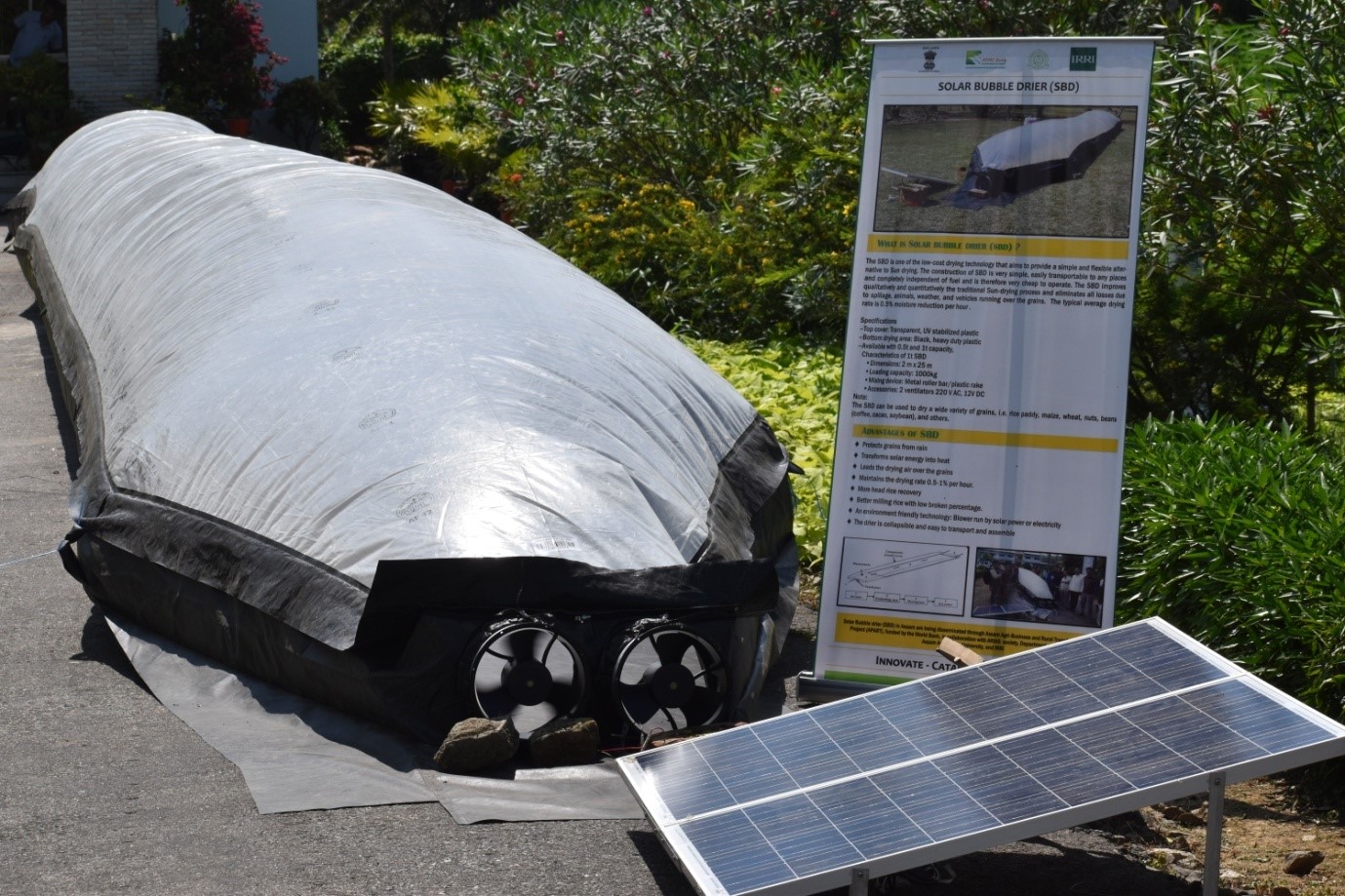


After harvesting, the rice paddy undergoes postharvest processes including drying, storage and milling to ensure good eating-quality and marketability.

Harvesting the crop on time is very important to maximize yields and grain quality. Crops harvested too early will have many unfilled and immature grains. Immature grains break easily when milled and will not germinate when used as seed. If crops are harvested late, heavy losses occur through shattering and bird attack. Quality also decreases due to grain weathering, resulting in breakage and downgrading due to undesirable grain colour.


Rice is usually harvested at grain moisture content (MC) between 20 and 25% (wet basis). Any delay in drying, incomplete drying or uneven drying results in qualitative and quantitative losses, such as:

The Solar Bubble Dryer (SBD) is the latest low-cost drying technology developed by IRRI, Hohenheim University and GrainPro. The SBD is mobile and is completely independent from fuel or the power grid, and therefore has very low operating cost. It comes in different sizes, with current models having 0.5 and 1.0 ton batch capacity.
The SBD uses energy from the Sun in two ways. First, the drying tunnel serves as a solar collector to convert the energy contained in the sunrays entering the transparent top of the drying tunnel to heat, which increases the temperature of the drying air for faster drying. Second, it is equipped with a photovoltaic system consisting of a solar panel, a deep cycle rechargeable battery and a controller to generate electricity that drives a small blower to move air through the drying tunnel, inflate the tunnel, and remove the water evaporated from the grains placed inside the tunnel. A simple roller dragged on ropes attached to the ends underneath the tunnel is used for mixing the grains without the need to open the tunnel. A rake for internal mixing is also available.
The SBD improves the traditional sun-drying process, in which farmers spread the paddy in the open under the sun, by protecting it from animals, insects, contamination and rain. The drying tunnel also provides a buffer for the temperature and protects the grains from overheating, as it is common during sun-drying at noon.

Rice is best stored as paddy because the husk provides some protection against insects and prevent grain quality deterioration. A safe or hermetic storage system prevents the grain from getting wet after drying and also gives protection from insects, rodents, and birds.
A rule of thumb for seed is that the life of the seed is halved for every 1% increase in moisture content or a 5°C increase in storage temperature above recommended levels.


Milling rice paddy removes the husk and bran layer to produce white rice. Rice is best milled at 13–15% moisture content. Best results are attained when the process is completed in a number of stages. Grain temperatures should not exceed 45°C during the process. An efficient mill removes the husk (20%), the bran or meal (8–10%), and leaves 70% as white rice. Rice grown in irrigated systems should attain 60% white rice as head rice (unbroken, white kernels), and in rainfed systems, 40–50% as head rice. Rice is milled in several ways-


After harvesting, the rice paddy undergoes postharvest processes including drying, storage and milling to ensure good eating-quality and marketability.
Milling degree or colour: The degree of milling or amount of the brown rice removed, affects the colour of white rice, and often the price. Under-milled rice absorbs water poorly, does not cook well, and is normally cheaper.
Head rice or broken percentage: Milled rice, having 75-80 % head rice (whole kernels), also includes broken kernels. High head rice yield is one of the most important criteria for measuring milled rice quality. High-quality rice normally has less than 5% broken grains.

Whiteness or translucency:This characteristic is a combination of varietal physical characteristics and the degree of milling. During milling, the whitening and polishing process greatly affects the whiteness of the grain and its transparency.
Chalkiness:Grain appearance is affected by the amount of chalkiness or white belly. Chalkiness is caused by interruption in the final grain-filling. Though chalkiness disappears upon cooking (and has no direct effect on cooking and eating qualities), excessive chalkiness often downgrades the quality and reduces milling recovery.
Chemical characteristicsGelatinization temperature or cooking time: Environmental conditions such as temperature during ripening influence gelatinization temperature. There is normally a preference for rice with intermediate gelatinization temperature.
Amylose content or stickiness: The amylose content of rice usually ranges from 15–35%. High-amylose rice has high volume-expansion, the grains cook dry, are less tender, and become hard upon cooling. Low-amylose rice cooks moist and sticky. Intermediate-amylose rice (21–24%) is preferred in most rice-growing areas of the world.
Gel consistency: Gel consistency measures the tendency of the cooked rice to harden on cooling. Varieties with a softer gel consistency are preferred if rice is to be consumed after cooling, or if cooked rice with higher degree of tenderness is desired.
Jorhat, PIN - 785013 Assam